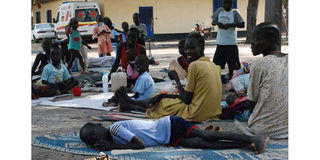Clinical trial seeks better treatment for kala-azar

Children recover from kala azar on the grounds of a hospital in Malakal, the capital of Upper Nile state in South Sudan. PHOTO| FILE| NATION
A clinical trial to find a better treatment for severe or chronic cases of post kala-azar dermal leishmaniasis (PKDL) in Africa has begun in Dooka, Sudan.
The objective of the trial, which is being conducted by the Drugs for Neglected Diseases initiative (DNDi), a non-profit research and development organisation, and the Institute for Endemic Diseases (IEND) at the University of Khartoum, is to shorten the length of hospitalisation for PKDL and deliver a treatment that is safer to use and easier to administer.
"Because PKDL is not a deadly disease, it has largely been ignored by public health efforts," said Dr Fabiana Alves, Head of Visceral Leishmaniasis Programme at DNDi.
"But the disease is highly stigmatising for people affected, and current treatments are simply not good enough. This is what we hope to change with this clinical trial."
PKDL is a form of leishmaniasis, a neglected parasitical tropical disease, which usually develops after a person has successfully completed visceral leishmaniasis (VL) treatment.
The disease is non-lethal, but is highly stigmatising because of the lesions that appear on a person's face and body.
PKDL is most common in Eastern Africa and South Asia. In Sudan, 50 to 60 per cent of VL patients will develop PKDL within six months after the end of the treatment. This is the highest PKDL rate worldwide.
TOXICITY
In Africa, the current treatment for PKDL is sodium stibogluconate (SSG), a drug that is associated with high risk of toxicity when used for the long treatment duration of 40 to 60 days.
SSG is also impractical, as it is an injectable drug that needs to be administered under close supervision in a hospital setting, due to its side effects.
Due to the limitations of this treatment, only the severe or chronic cases that do not self-heal after six months and which may develop disfiguring skin lesions causing scars and social stigma are currently treated.
The clinical trial will assess the safety and efficacy of two treatment combinations. The first is a combination of paromomycin, an injectable treatment, with the oral drug miltefosine, currently not approved for use in Africa.
The second is a combination of intravenous liposomal amphotericin B, currently used as a second-line treatment for VL in Africa, with miltefosine.
"If either of these treatment options are proven to be safe and efficacious, PKDL patients will not need to spend many days in hospital. They can be treated for a few days at the hospital, then complete the oral treatment at home," said Dr Brima Younis, IEND, principal investigator for the study.
The clinical trial will run for a period of three years and enroll 110 patients."Many scientific questions around PKDL have remained unaddressed," said Dr Jorge Alvar, Senior Advisor for leishmaniasis at DNDi.
"In both Eastern Africa and South Asia, PKDL is thought to play an important role as a reservoir of leishmaniasis parasites that maintains the transmission cycle, and therefore poses a threat to control and elimination efforts of the disease. We need more investment in this neglected area."

